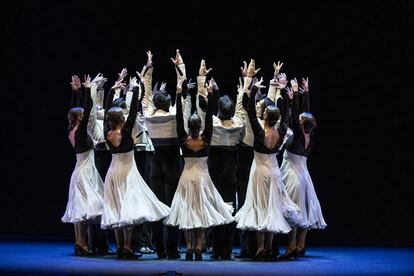The teachings of musical historiography are exactly valid to be applied to the evaluation of the choreographic repertoire in practically all branches of dance and ballet. In fact, Rameau, and not only him, in his time, explained and established these terms and rigors in the conservation and transmission of the works that were to constitute the artistic building and its “interior decoration”, its contents. Choreography has always shown its fragility when it comes to being manipulated and replaced, but this adventure, full of ethical and principal duties within the practice of dance, is the first task where the progression and solidity of this patrimonial house will be established. Inside there is also innovation and experimentation, the past is sought and recreated with an eye to the future. We can move the furniture around, but always keep it clean.
That said, the Spanish ballet schools, from the works produced in their approximate technique of stick dancing to theatrical and stage flamenco – now very evolved – have lived, as modern art of the 20th century that it is, in the uncertainty of a rather precarious stability, a “you get out so I can get in.” It is true that there is no systematic, nor a rigorous historical order in Spanish ballet, nor in many creators, the will for that pertinence and thirst for permanence. The phrase “bread for today and hunger for tomorrow” is appropriate. The National Ballet of Spain (BNE), which should be the main custodian, has only done so partially and lives, today as yesterday and hastily, off its income. Rhythms It is a classic that must be followed; Shout (1997) aspires to be so and, already settled in its most immediate memorial and plastic deposit, it is represented with that search well deserved by its own values.
Since the time of Maria de Avila, who personally commissioned it, it was said, as a kind compliment, that Rhythms It would be, in the future – it has already worked like this almost from the beginning – The Sylphs (Fokin) of the Spanish ballet. Namely: an exquisite all-purpose ballet, without a narrative plot, with soloist brilliance, ideal for opening programs and setting a letter of introduction. And so it is. Last Saturday, July 13, Rhythms The choreographer has celebrated the round number of 40 years since its world premiere at the same Teatro de La Zarzuela in Madrid and the work is dedicated by its creator, Alberto Lorca, to Encarnación López La Argentinita. This provides clues. Those interested can be encouraged to review the choreographer’s biography, where they will find more identifying features and explanations for many things that later appear, crystallized, in Rhythms. Its suitability is sought, it is very cerebral and studied.
The BNE staff dances with a certain ferocity, height and rigor; they dance well, all together, even though there is an egalitarian tendency hovering over the performance that raises artistic doubts. Another thing is the nuances, which are missing at times, a certain connection and smoothness of the styles that today are becoming more moderate in a more exposed, immediate and expeditious way of dancing that sometimes harms the reading and the intentions of a given work. Rhythms The choral geometry is a demonstration of the power of the ensemble, the strength of the Spanish school in its role as a conquering troop. Some things have changed, such as the lights, which previously defined the scenes and cut them out with almost surgical precision. The costumes remain faithful to the originals by interior designers Pin Morales and Román Arango, who in their day formed a tandem that was synonymous with elegance and good taste.
For its part, Shout Canales, always restless with the experiment, with all the contemporary air assimilated in his French adventure, which began with Electric shock, by Maguy Marin. The work Shout It resists, it has its poetry and it transmits essences and figures, like verses in the air colored by theatrical light. Shout reappears well danced, with the pleasant surprise of the guests Mónica Fernández and Pol Vaquero, today mature artists, with a steely individuality and possessors of a very lively stage presence that provides a seasoning with roots and security.
GENERATIONS
Spanish National Ballet. Director: Ruben Olmo. Musical direction: Manuel Coves; piano: Jose Luis Franco. Rhythms: Alberto Lorca / Jose Nieto; Pastorela: Antonio Ruz / Manuel Blasco de Nebra; Scream: Antonio Canales / Jose Maria Bandera, Jose Carlos Gomez and others. La Zarzuela Theatre, Madrid. Until July 28.

